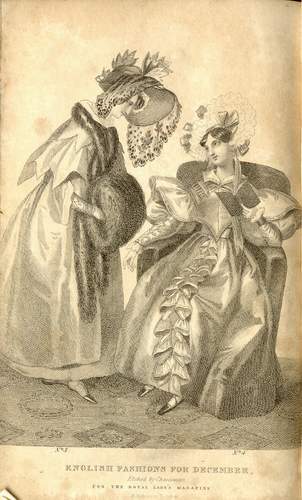 English Fashions
English FashionsPlate 1, Fig. 1.
Full evening or ball dress of very rich white satin. The skirt is very full, and rather short, and has a beautiful trimming of crimson velvet and tulle, at the usual height. The body is plaited lengthwise, in very small plaits. It is cut low and quite square, with a deep fall of blonde. A stomacher of crimson velvet, cut in three points at the waist, and edged with narrow blonde, finishes the corsage. The sleeve is full, with a second fall of blonde, and finished with a band of velvet. Coiffure, a la Maria de Gloria. Earrings and necklace of pearls and emeralds. Gloves and shoes of white satin.
Fig. 2.
Dinner costume. Dress of claret-coloured satin. The corsage is made uni, and cut square across the bust. A full fold of satin, deeply indented at one edge, crosses the front of the corsage en schall, and forms a full epaulette. The under sleeve is short and full, over which is a long sleeve of crepe lisse, as well at bottom as at top, and confined at the waist by a deep band of satin. The skirt has a deep hem, surmounted by a garniture of small leaves, each divided nearly to the bottom, and edged with double cording. A toque of gold tissue, with ostrich feather sand folds of satin, gives an appropriate and elegant finish to this dress. Necklace and earrings of pearls. Shoes of claret satin, and white kid gloves.
Plate 2, Fig. 3.
Walking dress of aventurine merino. Manteau of cerise gros de Tours, mad full and confined to the shape at the back part of the waist. The manteau is not trimmed down the front, but has an elegant pelerine, of an entirely new pattern. Capote of cerise terry velvet, made small, and with a light simple trimming of white satin or gauze ribbon. A rich Chantilly veil is sometimes worn with it. Muff and boa of sable, or ermine. Bottines of aventurine silk.
Fig. 4.
Morning dress of laurel-green reps. This dress will suit equally well for a pelisse, being very richly trimmed down the front. The skirt is very full, but it has no other finish than a deep hem, the work of which is visible. The corsage is made close up to the neck, and quite plain. The sleeve is of a novel description and very becoming. It is in two parts; the under, or back part, is close to the arm all the way down, while the front part is very full from top to bottom, but much more so at the upper part, and at regular distances is cut into pointed leaves, which are brought through openings cut in the scalloped edge of the back part, forming a rich garniture the whole length of the arm. The cape is cut very full on the shoulder, and in a point at the ceinture. The fulness is confined by folded bands on the shoulder, and left gree over the sleeve, where it forms a full jockey. The collar is cut in points, and is edged with three narrow rouleaux, as is also the cape. Morning cap of fine lace, and pale rose gauze ribbon. Black satin shoes.
|
 Home now, please!
Home now, please!